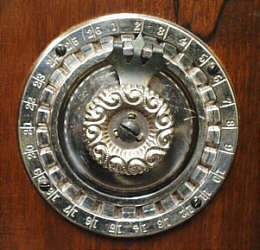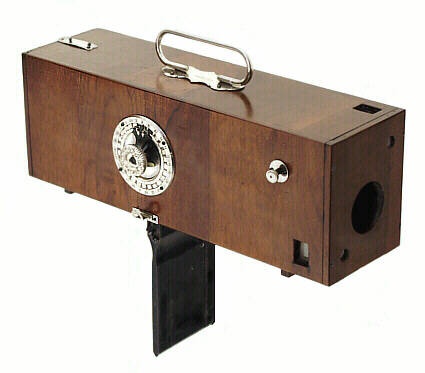|
|



Copyright ©2002 by Rob Niederman - ALL RIGHTS RESERVED
Visit the Nodark Camera Reference page
Return to the Solid Body & Box Cameras page
Return to the Solid Body & Box Cameras page
Since the beginning of photography, makers pursued the dream of building
cameras that developed pictures in the field. The earliest cameras were based
on the laborious "wet" process, which imposed limitations on the photographer.
Invention of the dry-ferrotype process in the 1890s changed this. It allowed
makers to create a new generation of cameras that allowed photographers
unparalleled freedom.
The Nodark represents one of the first cameras designed to take advantage of the newly invented dry-ferrotype process. It was a simple box camera that made 2½ x 3½ inch images. Price was $6 (about $122 in year 2000 currency).
The Nodark's simple design accommodated twenty-six plates. Its polished wood body design featured two reflex finders, carrying handle, and a nickel plated dial to change ferrotype plates.
The Nodark represents one of the first cameras designed to take advantage of the newly invented dry-ferrotype process. It was a simple box camera that made 2½ x 3½ inch images. Price was $6 (about $122 in year 2000 currency).
The Nodark's simple design accommodated twenty-six plates. Its polished wood body design featured two reflex finders, carrying handle, and a nickel plated dial to change ferrotype plates.
Multi-Lens Cameras | View Cameras | Self-Casing Cameras | Solid Body Cameras | References & Advertisements
Home | What's New | Show Schedule | Wanted | For Sale | Links | Site Map | Email
Home | What's New | Show Schedule | Wanted | For Sale | Links | Site Map | Email
Nodark Camera, c.1899-?
Popular Photograph Company. NY.
Popular Photograph Company. NY.
According to the instruction sheet, development was relatively straightforward after an exposure was made:
Nodark fitted with its rarely found developing tank.
Fill the developing chamber with liquid No.1, and fix the chamber on slot on bottom of Camera-(see that shutter in
chamber is open), pull out slide in bottom of Camera, and plate will drop into the chamber. Push slide in Camera back
in place, CLOSE the shutter in chamber and remove chamber from Camera. Slightly shake the chamber, and in
thirty-five seconds pour liquid back in bottle No.1, and without opening the chamber, fill it with liquid No.2. This will
FIX the picture in from twenty to thirty seconds.
The Nodark's interesting history doesn't end here. After acquiring the camera shown on this webpage, and reading the original instruction sheet, I
uncovered two historically interesting tidbits. Although this information is minor in the grand scheme of photographic history, it does provide
interesting new insights about the camera and its maker.
The first new piece of information was discovering that the Nodark was also advertised for use with dry-glass plates. Up until now, the camera was widely regarded exclusive to the dry-ferrotype process. The reverse side of the instruction sheet is dedicated to describing the camera's operation for use with "dry glass plates." According to the directions, each Nodark outfit included a set of "cardboards" that were placed in between each glass plate. This ensured that one plate did not expose the one immediately behind.
The instruction sheet also included reference to a company by the name of Merchants Specialty Mf'g. Co., 90 Warren Street, New York, N.Y., instead of the Popular Photograph Co. (the generally accepted maker). In contrast, owner's manuals (as opposed to single instruction sheets) and advertising listed the Popular Photograph Company as the maker.
To unravel this mystery, I contacted Eaton Lothrop for his opinion. As a side note, Mr. Lothrop is a photohistorian, author of numerous articles and the highly regarded book A Century Of Cameras ... which includes an entry for the Nodark. On one of his trips to New York, Eaton graciously visited the New York Public Library and dug up the following information:
The first new piece of information was discovering that the Nodark was also advertised for use with dry-glass plates. Up until now, the camera was widely regarded exclusive to the dry-ferrotype process. The reverse side of the instruction sheet is dedicated to describing the camera's operation for use with "dry glass plates." According to the directions, each Nodark outfit included a set of "cardboards" that were placed in between each glass plate. This ensured that one plate did not expose the one immediately behind.
The instruction sheet also included reference to a company by the name of Merchants Specialty Mf'g. Co., 90 Warren Street, New York, N.Y., instead of the Popular Photograph Co. (the generally accepted maker). In contrast, owner's manuals (as opposed to single instruction sheets) and advertising listed the Popular Photograph Company as the maker.
To unravel this mystery, I contacted Eaton Lothrop for his opinion. As a side note, Mr. Lothrop is a photohistorian, author of numerous articles and the highly regarded book A Century Of Cameras ... which includes an entry for the Nodark. On one of his trips to New York, Eaton graciously visited the New York Public Library and dug up the following information:
Popular Photograph Co.
1896-1897: no listing
1897-1898: 32 Liberty Street
1898-1899: 114 Bleecker St.
1899-1900: 114 Bleecker St.
1900-1901: 114 Bleecker St.
1901-1902: 150 Bleecker St.
1903-1904: no listing
1896-1897: no listing
1897-1898: 32 Liberty Street
1898-1899: 114 Bleecker St.
1899-1900: 114 Bleecker St.
1900-1901: 114 Bleecker St.
1901-1902: 150 Bleecker St.
1903-1904: no listing
Note: Cosaque is the name of a French made magazine camera.
That's it! After admiring the image, the photographer could shoot a new picture by turning the nickel-plated dial on the side of the camera to
position a fresh plate. Because the entire exposure and development process was performed without a darkroom, the "Nodark" moniker (No Dark)
represented more than just a name.
Detail of the ornate plate changing mechanism.
Twenty-six notches correspond to the number
of plates loaded in the camera's wood magazine.
Because the entire exposure and development process was performed without a darkroom, the "Nodark" moniker (No Dark) represented more than just a name.
Yet several years later, the name proved to be a problem. In 1901, Kodak, Ltd. felt that "Nodark" infringed on its trademark. Action was swift, as noted in the February 1901 issue of The Photogram:
Twenty-six notches correspond to the number
of plates loaded in the camera's wood magazine.
Because the entire exposure and development process was performed without a darkroom, the "Nodark" moniker (No Dark) represented more than just a name.
Yet several years later, the name proved to be a problem. In 1901, Kodak, Ltd. felt that "Nodark" infringed on its trademark. Action was swift, as noted in the February 1901 issue of The Photogram:
"Cosaque" and "No Dark" are two trade names which, on the action of
Kodak, Ltd., have been withdrawn by the users, the Court ruling that their
resemblance to "Kodak" constituted an infringement of the rights of Kodak,
Ltd., in the use of this word.
Merchant's Specialty Mfg. Co.
--
1897-1898: no listing
1898-1899: silverware - 110 Reade Street
1899-1900: plated ware - 110 Reade Street
1900-1901: 110 Reade Street
1901-1902: plated ware - 110 Reade Street
1903-1904: silverware - 90 Warren Street
1904-1905: silverware - 90 Warren Street
1905-1906: no listing
--
1897-1898: no listing
1898-1899: silverware - 110 Reade Street
1899-1900: plated ware - 110 Reade Street
1900-1901: 110 Reade Street
1901-1902: plated ware - 110 Reade Street
1903-1904: silverware - 90 Warren Street
1904-1905: silverware - 90 Warren Street
1905-1906: no listing
A side-by-side company comparison (left), although
inconclusive as to which is the Nodark's actual maker, allows
us to draw some inferences. For example, we can conclude
that the "Merchants" address appearing on instruction
sheets could not date any earlier than 1903. Additionally,
"Popular's" last listing is 1901 - 1902 while "Merchant's" first
Warren Street listing is 1903. Coincidence?
To speculate momentarily, there could have been a business relationship between the two companies - "Merchants" fabricating nickel-plated parts
for the Nodark and possibly assembling the actual camera - implying that the Popular Photograph Company was the original maker. Pushing the
speculation envelope even further, "Popular" may have encountered financial difficulties and sold all Nodark rights and inventory to "Merchants."
"Merchants" may have attempted to continue marketing the camera, failed, and closed out the remaining inventory or simply went bankrupt after
1905. A similar business arrangement occurred later in 1908 when the Multiscope & Film Company sold all of its Al Vista rights, patents, and
equipment to the Conley Camera Company.
Any further information (such as company documents and inventory records) would be appreciated.
Any further information (such as company documents and inventory records) would be appreciated.
